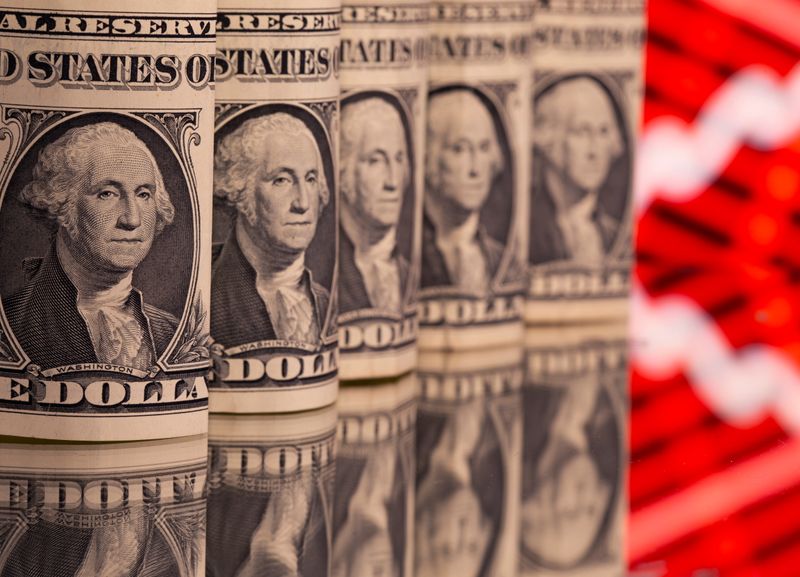By Herbert Lash and Samuel Indyk
NEW YORK/LONDON (Reuters) -The dollar weakened on Monday as markets bet the Federal Reserve will slow if not halt its raising of interest rates to curb inflation after U.S. authorities moved to limit the fallout from the sudden collapse of Silicon Valley Bank.
President Joe Biden said the administration’s swift actions to ensure depositors can access their funds in Silicon Valley Bank (SVB) and Signature Bank (NASDAQ:SBNY) should give Americans confidence that the U.S. banking system was safe.
The Fed on Sunday announced it would make additional funding available through a new Bank Term Funding Program, which would offer loans of up to one year to depository institutions, backed by Treasuries and other assets these institutions hold.
The dollar fell, with the dollar index, a measure of the greenback against six other currencies, sliding 0.59% as short-dated Treasury yields tumbled and reduced a major driver of the U.S. currency’s recent strength.
The two-year note’s yield plunged 57.2 basis points to 4.016% in the biggest one-day drop since the Black Monday stock market crash of 1987.
“Despite the quite significant financial risk nature of these developments over the past few days, we really haven’t seen a bid for the dollar from a safe-haven or liquidity point of view,” said Shaun Osborne, chief FX strategist at Scotiabank in Toronto.
“It is largely a reflection of the market’s repricing the Fed rate outlook, at least in the short-term point of view.”
Fed funds futures slid, with expectations of the Fed’s terminal rate sliding to 3.84% in December from above 5% last week.
Goldman Sachs (NYSE:GS), among other big banks, said it no longer expected the Fed to deliver a rate hike at the end of its two-day policy meeting on March 22.
Barclays (LON:BARC) said that the latest bout of financial market jitters introduced significant uncertainty into the market and that policymakers will pause at next week’s meeting.
Futures showed a 43.9% chance of no increase in rates at next week’s meeting, according to CME’s FedWatch Tool. A week ago futures were pricing about the same probability of a 50 basis point rate hike by policymakers.
CPI IN FOCUS
With speculation rampant on how the Fed will handle monetary policy and fight to rein in inflation, the market focus turns to the release on Tuesday of the consumer price index data.
“If we get a hotter than expected CPI print tomorrow, that would be a bit of a risk,” Osborne said. “We’re still looking at a U.S. economy that is experiencing a very tight labor market, very high wage growth and above-target inflation so the case for higher rates is still quite strong.”
Safe-haven currencies, such as the Japanese yen and Swiss franc, benefited from the fallout from SVB.
The Japanese yen strengthened 1.26% at 133.33 per dollar, while the dollar fell 1.02% against the Swiss franc at 0.912.
The euro rose 0.79% to $1.0727. Earlier, it hit a near one-month high of $1.0737, ahead of the European Central Bank’s policy meeting on Thursday.
Expectations call for the ECB to deliver a 50-basis-point hike, said Niles Christensen, chief analyst at Nordea.
“The question is how hawkish will the ECB be. We think they’ll signal there will be more rate hikes to come,” he said.
Sterling traded at $1.2181, up 1.27% on the day. The Mexican peso, which has been stronger than the dollar all year, lost 2.32% versus the greenback at 18.94.
The Australian dollar jumped 1.37% to $0.667, on track for its biggest one-day percentage jump since Feb. 7.
Bitcoin and other cryptocurrency soared as investors breathed a sigh of relief that regulators had moved to bolster the U.S. banking system. Bitcoin rose 20.54% to $24,223.00.



